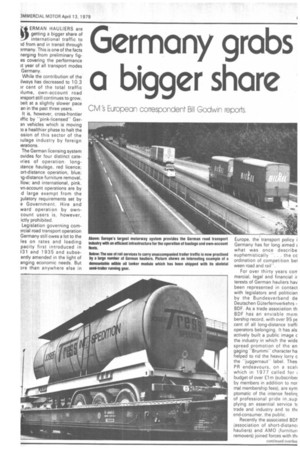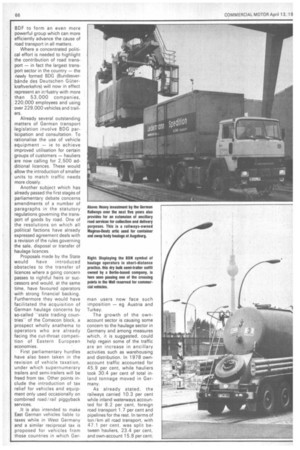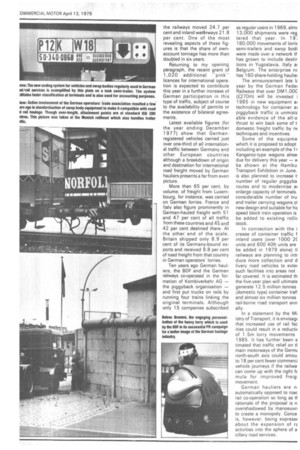Germany grabs bigger share
Page 67

Page 68

Page 69

If you've noticed an error in this article please click here to report it so we can fix it.
CM "s European correspondent Bill Godwin reports,
4ERMAN HAULIERS are getting a bigger share of international traffic to id from and in transit through armany. This is one of the facts nerging from preliminary figes covering the performance ;t year of all transport modes Germany.
While the contribution of the ilways has decreased to 10.3 )r cent of the total traffic flume, own-account road msport still continues to grow, beit at a slightly slower pace an in the past three years.
It is, however, cross-frontier iffic by "pink-licensedGeran vehicles which is moving :o a healthier phase to halt the osion of this sector of the iulage industry by foreign ierations.
The German licensing system ovides for four distinct cateiries of operation long;lance haulage, red licence; ort-distance operation, blue; -ig-distance furniture removal, How; and international, pink. vn-account operations are by
d large exempt from the )ulatory requirements set by e Government. Hire and ward operation by owncount users is, however, ictly prohibited.
Legislation governing cornarcial road transport operation Germany still owes a lot to the les on rates and loading pacity first introduced in 131 and 1935 and subseently amended in the light of anging economic needs. But D re than anywhere else in
Europe, the transport policy i Germany has for long aimed what was once describe euphemistically ". . . the cc ordination of competition bet ween road and rail".
For over thirty years con mercial, legal and financial ir terests of German hauliers hay been represented in contact with legislators and politician by the Bundesverband de Deutschen Guterfernverkehrs BDF. As a trade association th BDF has an enviable mem bership record, with over 95 pe cent of all long-distance traffi operators belonging. It has als actively built a public image c the industry in which the wide spread promotion of the en gaging "Brummi" character ha helped to rid the heavy lorry c the -juggernautlabel. Thes PR endeavours, on a seal, which in 1977 called for budget of over El m (subscribe( by members in addition to nor mal membership fees), are sym ptomatic of the intense feelinc of professional pride in sup plying an essential service t( trade and industry and to thf end-consumer, the public.
Recently the associated BDr (association of short-distanci hauliers) and AMO (furnituri removers) joined forces with thi
continued over-lea BDF to form an even more powerful group which can more efficiently advance the cause of road transport in all matters.
Where a concentrated political effort is needed to highlight the contribution of road transport — in fact the largest transport sector in the country — the newly formed BOG (Bundesverbande des Deutschen G Literkraftverkehrs) will now in effect represent an industry with more than 53,000 companies, 220,000 employees and using over 229,000 vehicles and trailers, Already several outstanding matters of German transport legislation involve BOG participation and consultation. To rationalise the use of vehicle equipment — ie to achieve improved utilisation for certain groups of customers — hauliers are now calling for 2,500 additional licences. These would allow the introduction of smaller units to match traffic needs more closely.
Another subject which has already passed the first stages of parliamentary debate concerns amendments of a number of paragraphs in the statutory regulations governing the transport of goods by road. One of the resolutions on which all political factions have already expressed agreement deals with a revision of the rules governing the sale, disposal or transfer of haulage licences.
Proposals made by the State would have introduced obstacles to the transfer of licences where a going concern passes to rightful heirs or successors and would, at the same time, have favoured operators with strong financial backing. Furthermore they would have facilitated the acquisition of German haulage concerns by so-called ''state trading countriesof the Comecon block, a prospect wholly anathema to operators who are already facing the cut-throat competition of Eastern European economies.
First parliamentary hurdles have also been taken in the revision of vehicle taxation, under which supernumerary trailers and semi-trailers will be freed from tax. Other points include the introduction of tax relief for vehicles and equipment only used occasionally on combined road/rail piggyback services.
It is also intended to make East German vehicles liable to taxes while in West Germany and a similar reciprocal tax is proposed for vehicles from those countries in which Ger
man users now face such imposition — eg Austria and Turkey.
The growth of the ownaccount sector is causing some concern to the haulage sector in Germany and among measures which, it is suggested, could help regain some of the traffic are an increase in ancillary activities such as warehousing and distribution. In 1978 ownaccount traffic accounted for 45.9 per cent, while hauliers took 30.4 per cent of total inland tonnage moved in Germany.
As already stated, the railways carried 10.3 per cent while inland waterways accounted for 8.2 per cent, foreign road transport 1.7 per cent and pipelines for the rest. In terms of ton/km all road transport, with 47.1 per cent, was split between hauliers, 23.4 per cent, and own-account 15.8 per cent; the railways moved 24.7 per cent and inland wathrways 21.8 per cent. One of the most revealing aspects of these figures is that the share of ownaccount tonnage has more than doubled in six years.
Returning to my opening paragraph, the recent grant of 1,020 additional "pink" licences for international operation is expected to contribute this year in a further increase oi .German participation in this type of traffic, subject of course to the availability of permits or the existence of bilateral agreements.
Latest available figures (for the year ending December 1977) show that Germanregistered vehicles carried just over one-third of all international traffic between Germany and other European countries although a breakdown of origin and destination for international road freight moved by German hauliers presents a far from even picture.
More than 65 per cent, by volume, of freight from Luxembourg, for instance, was carried on German lorries. France and Italy also figure prominently in German-hauled freight with 51 and 47 per cent of all traffic from these countries and 45 and 42 per cent destined there. At the other end of the scale, Britain shipped only 8.9 per cent of its Germany-bound exports and received 9.8 per cent of road freight from that country in German operators' lorries.
Ten years ago German hauliers, the BDF and the German railways co-operated in the formation of Kombiverkehr AG — the piggyback organisation — and first put trucks on rails by running four trains linking the original terminals. Although only 15 companies subscribed
as regular users in 1969, alm( 13.000 shipments were reg tered that year. In 19: 180,000 movements of !oak semi-trailers and swop bodi were made over a network ft has grown to include destir tions in Yugoslavia, Italy al Belgium. The enterprise n( has 160 share-holding hauliei The announcement late le year by the German Fedei Railways that over DM1,00C 270m) will be invested i 1985 in new equipment al technology for container al piggyback traffic is unmiste able evidence of the all-o thrust to win back some of t domestic freight traffic by nt techniques and incentives.
Some of the equipme which it is proposed to adopt including an example of the Kangaroo-type wagons alma' 'due for delivery this year — be shown at the Hambu Transport Exhibition in June. is also planned to increase tl number of regular piggyba routes and to modernise al enlarge capacity of terminals. considerable number of tru and trailer carrying wagons ol new design and suitable for hil speed block train operation is be added to existing rollir stock.
In connection with the i crease of container traffic f inland users (over 1000 2( units and 600 40ft units are be added in 1979 alone) tl railways are planning to intr duce more collection and d livery road vehicles to exter such facilities into areas not far covered. It is estimated th the five-year plan will ultimatE generate 12.5 million tonnes (domestic type) container trafi and almost six million tonnes rail-borne road transport ann ally.
In a statement by the Mi istry of Transport, it is envisagi that increased use of rail fac ities could result in a reductic of 1.5m lorry movements 1985. It has further been e tirnated that traffic relief on II main motorways of the Germe north-south axis could amou to 18 per cent fewer commerci vehicle journeys if the railwa can come up with the right fc mule for improved freig movement.
German hauliers are n1 automatically opposed to roac rail co-operation so long as ti rationale of the proposal is n overshadowed by manoeuvri to create a monopoly. Conce is, however, being express( about the expansion of re activities into the sphere of a ciliary road services.
















































































































